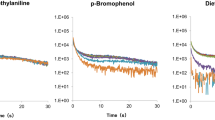Abstract
Hazard assessment often needs to compare inhibition values of different test species and different test durations. But the three different methods to calculate inhibition in growth inhibition tests (final biomass, growth rate, area under the growth curve) may lead to very different and sometimes contradicting numerical sensitivities of the test species. This paper will depict why there are these different results and what consequences this has for the evaluation of results. Comprehensive discussion of different aspects will show that using growth rate may eliminate most of the problems occurring for comparisons between test species, different test times and different laboratories. The use of growth rate and the adaptation of toxicity levels maximises reproducibility, comparability and biological sensitivity of biotests.
Similar content being viewed by others
References
Fairchild, J.F., Ruessler, D.S., Haverland, P.S. and Carlson, A.R. (1997). Comparative sensitivity of Selenastrum capricornutum and Lemna minor to sixteen herbicides. Arch. Environ. Contam. Toxicol. 32 , 353–7.
Fletcher, J.S. (1990). Use of algae versus vascular aquatic plants to test for chemical toxicity. In W. Wang and J.W. Gorsuch, W.R. Lower (eds). Plants for Toxicity Assessment . ASTM STP 1091. pp. 33–9. Philadelphia PA: American Society for Testing and Materials.
ISO (2000a). ISO/WD 20079, Working Draft, Duckweed growth inhibition test, December 2000.
ISO, (2000b). Personal communication, Pluta, Umweltbundesamt, Germany.
Nusch, E.A. (1982). Evaluation of growth curves in bioassays. ISO/TC 147/SC 5/WG5 N62. Nederlands Normalisatieinstituut, Delft, The Netherlands.
Nyholm, N. (1985). Response variable in algal growth inhibition tests-biomass or growth rate? Wat. Res. 19 , 273–9.
Nyholm, N. (1990). Expression of results from growth inhibition toxicity tests with algae. Arch. Environ. Contam. Toxicol. 19 , 512–22.
OECD (2000). Revised final draft 221, Duckweed growth inhibition test, October 2000.
Ratte, H.T., Hammers-Wirtz, M. and Cleuvers, M. (1998). Influence of the growth pattern on the EC50 of cell number, biomass integral and growth rate in the algae growth inhibition test. Umweltbundesamt Projekt Report No. 300030 10, Berlin, Germany.
Sloof, W.J., Canton, H. and Hermens, J.L.M. (1983). Comparison of the susceptibility of 22 freshwater species to 15 chemical compounds. I. (Sub)acute toxicity tests. Aquat. Toxicol. 4 , 113–28.
Author information
Authors and Affiliations
Corresponding author
Rights and permissions
About this article
Cite this article
Eberius, M., Mennicken, G., Reuter, I. et al. Sensitivity of Different Growth Inhibition Tests–Just a Question of Mathematical Calculation? Theory and Practice for Algae and Duckweed. Ecotoxicology 11, 293–297 (2002). https://doi.org/10.1023/A:1020536702081
Issue Date:
DOI: https://doi.org/10.1023/A:1020536702081




